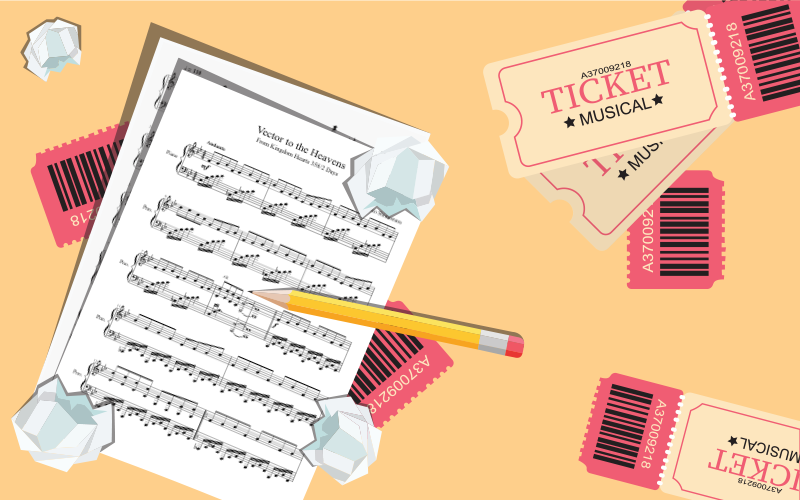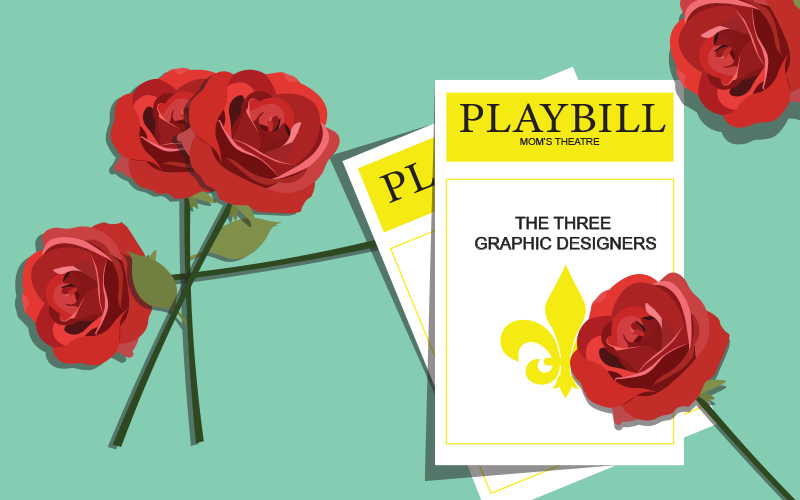Family lore holds that my great-grandfather, who owned a vegetable business near the corner of Polk and California in San Francisco, timed his deliveries to the St. Francis Hotel so that they’d coincide with Enrico Caruso practicing scales in a room above. When an earthquake and a fire devastated the city on the night of April 18, 1906, Caruso fled. The withdrawal of a talent that might have comforted thousands of refugees, meant that he was dead to our family.
Most of our theatrical history doesn’t involve a horse-drawn wagon full of tomatoes, or earthquakes and fires. Mostly, we attend theatre in the same manner as everyone else. Broadway lay 3,000 miles to the east but our choices were never limited by that distance. Even as late as the 1970s, there were still theatre stars, and they still toured in the shows that made them famous.
Lynn Fontanne once told Mary Martin, “If you intend to make the theatre your life, you must tour. You build your career, get the experience, create your own audiences, on the road.” My family reaped the benefits of that philosophy for more than a century.
I grew up hearing the story of my mother and grandmother going to the Curran Theatre in San Francisco, to see Victor Herbert’s The Red Mill. This was 1940; when my mother was ten years old. The company included a dancer named Gwen Verdon in her professional debut. Mom and Grandma sat so high on the second balcony that they couldn’t see the titular mill.
There was one stellar season at the Curran in 1957, when my parents, newly married, saw Mary Martin in South Pacific and Annie Get Your Gun back-to-back. A decade later my sister, Sheryl, and I would listen to the cast albums and dance around the living room. And, of course, we watched the semi-annual telecast of Peter Pan. You could spot the wires but the joy that Miss Martin emitted in flight makes the production out-class all the high-tech miss-fires that followed.
Miss Martin’s role in our family history reached new heights when I wrote to her, inviting her to attend a production of Peter Pan in which I was playing John Darling. Just as Peter promises Wendy that he’ll fetch her in time to do his spring cleaning, Miss Martin signed her note of regret with the words, “But there’s a spring cleaning every year, isn’t there?”
Like good parents everywhere, mine chose to pass along the joys they had experienced in their own lives. I was seven the first time my mother sat my sister, Sheryl, and me down in front of the old record player. She put on the original cast album of Hello, Dolly!, but lifted the needle between songs to fill in the plot. The next day we drove across the Golden Gate Bridge to attend a matinee at the Curran, where we watched Ginger Rogers descend that iconic red staircase and “rejoin the human race.” Two years later it was Douglas Fairbanks, Jr. in My Fair Lady. We saw Alice Faye in Good News and Sally Ann Howes in The Sound of Music and The King and I.
At 14, I had spent half my existence as a theatergoer and believed that life should be lived at the same pitch as those hours in the second balcony. I wanted my days to be orchestrated by Rodney Russell Bennett and designed by Oliver Smith. I was very hard to live with.
At last, the day came when an entirely new show arrived at the Curran. This was no golden age classic. It was straight from Broadway, and it was the hottest ticket in town.
Mom listened to the cast album in preparation, but I refused. I wanted to hear the score live for the first time, to test it, to see if I would leave the theatre humming tunes I’d never heard before. When the family drove across the bridge to see the original Broadway cast in A Chorus Line, it was The Red Mill all over again. We sat so high in the balcony that we didn’t know there was a mirror at the back of the stage, or that Donna McKechnie’s solo was danced with multiple reflections of herself.
But I couldn’t speak, much less hum, when we left the theatre. A Chorus Line gave us something that the old chestnuts couldn’t. In the glare of the lights were openly gay men, some of them nonchalantly so, others struggling deeply. It gave us a grounding that would help us as a family when I began my slow emergence from the closet two years later.
A Chorus Line wasn’t our only step toward gay liberation. After all, this was San Francisco in the 1970s. Gay icons abounded. We saw Florence Henderson in The Sound of Music on Halloween and half the men in the audience were dressed as nuns. Then there was Liza Minnelli in the pre-Broadway tour of a show trying out under the title Shine It On, but soon to be renamed The Act.
The audience was packed with recent arrivals to the Castro and Polk Street neighborhoods; all of them reveling in certain freedom they’d not known in smalltown America. In the course of the show, a nebbishy supporting character told Miss Minnelli, “I have a problem. I’m gay.” The image is clear in my head. I can see them standing stage-left, near the proscenium. Aglitter in Halston, the star responded, “That’s not a problem.” The audience went nuts.
I was entranced by the energy, the defiance, the vulnerability of Miss Minnelli. The show was sold-out, but I was determined to see it again; and found two tickets offered in the local classifieds. Mom agreed to drive. It seemed a vastly different production — cleaner, tighter. It’s the first time I was aware that musicals aren’t born; they’re developed, massaged, rewritten. There was a new song that night, “City Lights,” and it stopped the show cold.

Mom and I waited at the stage door, along with an enormous crowd. It was a long wait and I was ready to give up. Mom’s the one who said we might as well stay. When Miss Minnelli finally emerged, a young man handed her an enormous bouquet of roses and got a smacking kiss in return.
As she made her way through the gauntlet of fans, I prayed that she’d make eye contact with me, but she looked right past me — to Mom. Miss Minnelli rolled her eyes, as if to say, “Isn’t this ridiculous?” and disappeared into a white limousine. On the long walk back to the empty parking lot, Mom gave me the car keys to hold, saying, “just in case someone grabs my purse. At least we can get home.”
Twenty years later I found myself at brunch with Miss Minnelli and lyricist Fred Ebb. I mentioned seeing The Act and how much I loved the song “It’s the Strangest Thing.”
Fred rasped out, “I don’t even remember that one.”
“Sure you do, Freddy,” Miss Minnelli said. And she sang a few bars.
By the time I was a sophomore in high school, I was seeing shows on my own. I could get on a bus a block from home, get off at Van Ness and Geary and walk down to the Curran. It was about this time that the Curran went upscale. The balcony was renamed the mezzanine and the second balcony was promoted to just “Balcony.” It didn’t change the fact that, for eight dollars, I could sit in those familiar rows, alone and happy.
I heard Patti Lupone sing “Meadowlark” in The Baker’s Wife before anyone knew who Patti Lupone was. I saw Deborah Kerr in The Last of Mrs. Cheyney. I stood on the pavement after the matinee of A Matter of Gravity, to watch Katherine Hepburn and a young actor named Christopher Reeve emerge from the stage door. Miss Hepburn emerged to a much smaller crowd than Miss Minnelli but she recognized familiar faces and called out to a trio of young women, “Here again, girls?” as she stepped into a modest town car.
Of my solitary trips to the Curran, it was Stephen Sondheim’s Pacific Overtures that left the deepest mark. It changed the way I thought about theatre and about history. I knew, too, that my parents would not have loved it as I did. It was complex, multi-layered. It was not optimistic about the future, nor did it shine a rosy light on the past. I was developing my own identity as a theatergoer. I was making choices.
My parents worked hard to meet my growing interest. We spent a week camping our way north to the Oregon Shakespeare Festival in Ashland. Each night, the family saw a classic in the outdoor Elizabethan theatre but one afternoon I went alone to one of the smaller, more intimate spaces. It was the first time I saw A Streetcar Named Desire. Life got deeper and more complicated.
We ventured still further, beyond theatre itself. Mom took me to see the Joffrey dance Romeo and Juliet. She got me out of school to hear Seiji Ozawa conduct Stravinsky’s Le Sacre du Printemps. I thought my heart would burst with the raw power of the music. Thirty years later, the same score would fuel a production of my play Nijinsky’s Last Dance, which would be seen at the Kennedy Center, festivals in South Africa, Edinburgh, Ljubljana and Dublin — and earn me lunch with Mikhail Baryshnikov.
In a cubicle at the Lincoln Center Library, Mr. Baryshnikov and I watched a tape of the play, with a phenomenal actor — Jeremy Davidson — in the role. That is, Baryshnikov watched the performance while I watched his reflection on the screen. Over lunch, he told me he liked it very much but wasn’t right for the part. He felt he didn’t have the skill to carry a one-man show in which Nijinsky is transformed into so many other characters. As my dream of outsized royalty checks slipped away, I suggested, “I could do some reworking of the piece, make it more suited to your particular skills.”
“No!” he cried. “You must not change a word. This is a great work of art.”
All I could think was: “I need to call Mom.”
There was no choice but to have a career in the theatre, given the way my spirit responded to all that my parents gave me. As with so many of us, I started by wanting to be a performer. Even in high school, I could describe the power of emotion that passes from the artist to the audience and back. I wanted to be a part of that equation.
I took dance classes — one year of ballet and three of tap. I was singled out in the local paper for those appearances in Peter Pan, and in a community Vaudeville show. I took acting classes, played supporting roles in the high school musical. But I wasn’t very good. I was too self-conscious and had a shaky sense of rhythm.
Happily, my dreams of writing predated my dreams of performing and would long outlast them. As a kid, when relatives asked what I wanted to be when I grew up, I would embarrass my parents by declaring, “I’m going to be a bookmaker!”
Our theatre history took a new turn when it began to include my own productions. My parents and sister showed up for the opening of Here to Stay, a five-character play performed in a 40-seat theatre in Boston. It centered on competing monologues between a son obsessed with musical theatre and a mother afraid that she had turned him gay by taking him to the theatre at an early age. “It was just . . . Kismet!” she concludes.
As my career progressed, the folks showed up for a series of productions in Washington and, most exciting, for my concert adaptation of Hammerstein and Kern’s Sweet Adeline, performed as part of the Encore series at New York City Center. Memories of Pacific Overtures and A Chorus Line pale beside the memory of leading my family down a backstage hall and hearing Broadway legend Dorothy Loudon call out, “Is that baby Norman’s mother out there? I need to talk to her.”
Mom disappeared through the dressing room door, leaving the rest of us alone in the hall. What transpired within was never revealed.
But there’s a memory stronger even than that and at a theatre much smaller than the vast City Center. When my mother began her eight-year battle with cancer, I started looking for theatre work closer to home. In the town of Sonora, just a few miles from my parents’ place on the western slopes of the Sierra Nevada, I found a small professional theatre company in search of a playwright.
Run by husband-and-wife team Dennis and Sara Jones, Sierra Repertory Theatre became my new theatrical home. I wrote two plays for them, an adaptation of The Three Musketeers that became my father’s favorite of my works, and a holiday tale based loosely on the work of Bret Harte, called The Christmas Foundling.
Mom was suffering from the side effects of chemotherapy and wasn’t sure she could make it to the Musketeers opening. As the hour approached, she rallied. She dressed, put on a string of pearls and a dab of Jean Nate. At the end of the performance, I suggested that we head home but Mom said she’d like to attend the party.

I settled us at a table, thinking we’d have a quiet chat and be on our way, but everyone wanted to meet her. Cast and crew took turns stopping by for a chat. And she shone. She discussed the merits of the production, of my work, of shows she’d seen in the past. People basked in her presence, as I had done all my life.
After my mother’s death, opening nights took on new significance. They were now nights on which she was absent, nights on which I couldn’t even call her with news of how it went. (At one point she had advised, “You’re just never going to get a good review from The Washington Post, honey. Maybe you should move.”) Sheryl, though, never failed to be present, hoping to make up for Mom’s absence.
Opening nights became intimate reunions. My sister was my date at champagne receptions. She was fussed over by the staff and acting company. It was a point of honor for her to be there on those vulnerable nights. Our love for each other deepened because of it. But that, too, would change.
As my father struggled through the final months of lung cancer, Sheryl was diagnosed with a recurrence of melanoma. When she visited me in Washington, we sat at brunch, and she showed me the raised lines of cancer visible just under the skin on the backs of her hands.
Opening nights since then are bittersweet — or avoided all together. A Broadway-sized musical that opened in Prague included a gala premiere with curtain calls for myself and my collaborators, along with press conferences and fountains of champagne. I manipulated my schedule so that I could attend rehearsals and previews but be unavailable for the opening and not have to take a bow to what, for me, would be an empty house.
Perhaps the most powerful moment in my own theatre history didn’t occur in a theatre at all, nor was it at lunch with Mikhail Baryshnikov, drinks with Stephen Sondheim, or brunch with Liza Minnelli. It happened in a modest kitchen north of San Francisco. I was about to finish high school and got it in my head that I needed to express my gratitude to my mother. She stood at the sink, doing dishes. I said to her back, “Mom, I want to thank you.”
She kept scrubbing. “For what, honey?”
“For all the stuff you’ve done. Taking us to the theatre when we were just kids. Doing it the way you did. Preparing us. Everything.”
She turned to me, suds on her hands, and said, “We’re your parents. It’s what we’re supposed to do. If you want to thank me, just do the same thing for your kids.” And she got back to work. •




